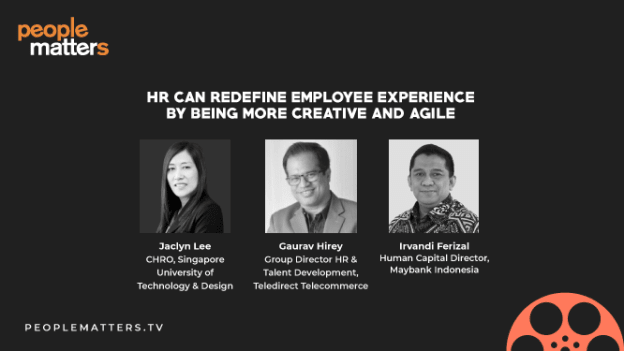HR can redefine employee experience by being more creative and agile

While the need to engage with internal and external consumers has been recognized with mounting passion and urgency across the globe, there often seems to be a nagging gap between initiative, planning, and execution.
Dr. Jaclyn Lee, Chief Human Resource Officer at Singapore University of Technology and Design, Gaurav Hirey, Group Director HR & Talent Development at Teledirect Telecommerce and Irvandi Ferizal, Director of Human Capital at Maybank Indonesia discuss, in conversation with Ester Martinez, CEO at People Matters, the implications, challenges and opportunities that employee experience has on business and how to leverage agility and design thinking to improve the same.
Form HR experience to employee experience
A key aspect of business transformation from the people perspective today is the move from having the HR experience at the center to having the employee experience at the heart of it all. There are litanies of factors that make this move an absolute requirement but a few aspects of the workplace today are accelerating the need to incorporate the employee experience filter while looking at any aspect of work.
Dr. Lee was of the opinion that, “With the shift in demographics of work, with millennials entering the workforce and the advancement of technology, there has been an increase in employees wanting to work for “good organizations”, to enjoy work and be part of something that adds value to them and to be able to truly contribute”.
Gaurav Hirey also pointed out that the time we live in, characterized by the digital breakout coupled with the increased pace of change and of business, employees today have higher expectations of their jobs. We live in an instant world with live messaging, chatbots, a general environment of reduced patience and an inherent habituation to needs to be met immediately.
Irvandi Ferizal is of the opinion that with the world of work already altered, we are now entering into the new normal of the human capital era and while the reality remains rooted in people, processes, products, and customers, there is an urgent need to need to have impact-focused initiatives to improve the employee experience.
Primary gaps to be bridged
It is often interesting to note how certain gaps prevail despite the majority trying to make a move forward. The major gaps deterring the improvement of employee experience seem to be the following:
Lack of consistency and planned execution: The movement toward better employee experience is larger than having the right slogans and interesting programs in place. There needs to be a deep connect of these initiatives with the business so that they are not planned in silos but rather in synch with the larger business picture. This would ultimately allow continued and consistent effort instead of spurts of activity followed by a complacent lull.
Resistance to meaningful mindset modification: Changing one’s mindset is often a tough battle and it is the same with HR. Organizations need to understand that HR management can no longer just be separated in terms of functional HR and transactional HR. Plugging in the paradigm shift also requires a shift in mindset and bridging traditional HR to technology. This is also crucial for the employee journey mapping and requires the amalgamation of various technology pieces.
The comfort of being outdated: HR teams often seem to be stuck in a time warp and need to be able to articulate the process around these challenging changes instead of getting comfortable in legacy. There is a need to be more creative and innovative, to develop a better commercial acumen to seer out the needed support and investment and thus create a wholesome employee experience.
Navigating challenges
Dr. Lee talked about the importance of mapping the employee digital life cycle to redesign the experience. She also said that it might help to speed up the process of pondering over changes. The need of the hour is to be able to walk the talk and create an environment that favors the digital leap. There are brainstorming tools today that can accelerate the process considerably. Companies just have to crack into the right tool based on their needs and culture.
“Start with the objective”, believes Irvandi Ferizal and highlights the need to think from the employee perspective so that the question of “what’s in it for me?” is always answered. He also mentioned the need to add a personal humanizing touch to all aspects of the business. Navigating the challenges our dynamic world throws at us are a little easier to manage when employees know that they are treated as prized human resources and not just means to an end.
Gaurav Hirey from Teledirect emphasized the need to look at employee experience holistically to ensure that the thought is infused at every level. At Teledirect, for example, there are employee champions to enable orientation and add that much needed personal touch. Another aspect that they never lose focus of is the fact that coaching to help accelerate employees’ career is a mainstay mandate for them.
Gestures such as these make a big difference to the employee experience on the whole and thus need to be assessed and analyzed often to ensure that they are making the difference that they are intended to make.
Making every step count
The employees’ digital lifecycle requires an end-to-end take on improving every aspect of their experience. Every step matters and every touchpoint counts from recruitment to learning to performance. Using agile design thinking helps in improving the experience each day in the journey. It is not just about the technology or the system or the scale of it but at the end of the day, it is about mapping every employee. This often requires a lot of user-testing and pulling in as much feedback as possible.
In order to be truly agile and to incorporate design thinking, often a lot of legacy processes have to undergo a complete renaissance and while there may be some resistance to that, such hurdles need to be overcome.
Ferizal talked about the motto of “recruit right, perform right, develop right and reward right” that is interwoven into the fabric at Maybank to connect with employees at every stage of their journey through the company. Improving the experience at every stage also requires the ability to manage by the heart rather than the hand.
Making a tangible business difference
Just as external customers are looking for velocity, agility, and visibility from all points of interaction, products, and services, employees too yearn for speed of action and flexibility, look for a level of live visibility that has become the norm through analytics and dashboards and seek a digitized experience that is relevant and relatable. With these aspects falling into place, employee experience does affect the business tangibly and the effects are seen retrospectively on levels of satisfaction, engagement, and attrition.
"Teledirect has witnessed employee satisfaction levels to go up considerably and attrition to go down by 50% in 3 years", since the start of their digital journey, said Gaurav Hirey. The ROI is thus measurable and worth the investment.
In order to plug in these changes and really make a difference to the employee experience, the effort needs to be sustainable and the HR must undergo a few changes. By becoming more creative, having an open mindset and embracing agility, HR teams today can drive the employee experience piece forward. The key is not always following the best practices but to understand what the best fit for an organization is and thus tweaking the employee experience accordingly. With the HR making a conscious focused effort to take change into their own hands, employees would also look at HR as a lot more than a vehicle to deliver piecemeal activities and thus would make an effort to partake in the change-scape as well.
Catch a re-run of the PeopleMatters TV show here!



